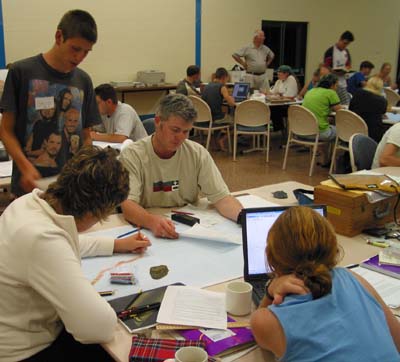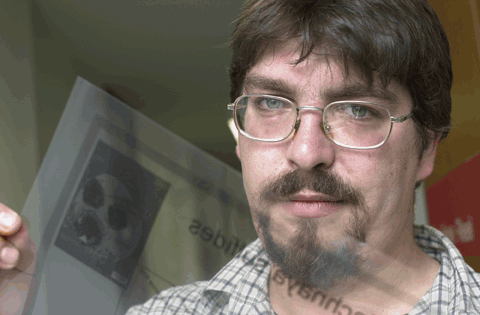Teaching
and training program
Undergraduate
Honours
Postgraduate
 |
 |
 |
 |
GEMOC's teaching program aims to:
- provide undergraduate and postgraduate students with a broad, integrative understanding of Earth architecture and processes, bridging the discipline boundaries of geology and geophysics
- train undergraduate and postgraduate students in new conceptual approaches and the applications of advanced technology, including geochemical analysis techniques and the integrated field and laboratory use of geographic information systems (GIS)
- develop international links in teaching programs (especially postgraduate) relevant to GEMOC's goals
- develop formal tailored course work components at postgraduate level which also can be packaged for distance education delivery and as short courses available to the mining industry
- enhance the pool of high quality geoscience graduates by restructuring academic programs to attract a new clientele
curriculum development
- As part of the Marine Geoscience strand of the new Bachelor of Marine Science, the Department of Earth and Planetary Sciences introduced a highly successful new first year unit, GEOS116 Marine Geoscience. The unit was run in a tailored problem-based learning (TPBL) format designed to develop a number of generic and science-specific skills concurrent with content delivery. The traditional problem-based learning approach was tailored to meet the needs of first year students coming directly from secondary education. The unit was closely evaluated throughout the semester, with surveys returning responses such as "good, challenging, fun - heaps different to other courses". The implementation of the approach was facilitated by a University Flagship grant awarded to members of the Department. In 2002, GEOS115 Earth Dynamics, Materials and the Environment will be repackaged along TPBL lines.
- A new degree, the Bachelor of Environmental Science in Environmental Geology began in 2001. The BEnvSc program is aimed at producing professional Environmental Geologists equipped with skills for employment in both urban geology and the resource sector. Students can also major in Environmental Geology within the BSc structure. Third year units to be taken by these students include GEOS315 Environmental and Groundwater Geophysics, GEOS377 Exploration and Environmental Geochemistry, and GEOS399 Soils. Students are routinely exposed to the state-of-the-art equipment in GEMOC's Geochemical Analysis Unit.
- The use of computer packages and web interfaces in Earth and Planetary Sciences is becoming a routine feature of content and skills delivery. Both geology and geophysics units incorporate packages used by industry into classroom and field teaching. Our portable computer lab was upgraded in 2001 (with University funding of $61,960) to ensure that student are able to access up-to-date computer software.
- GEOS224 Introduction to Field Geology was opened up to a wider clientele in 2001 including students enrolled in the new Marine Geoscience program. While the unit still covers an introduction to the traditional geological mapping skills and introductory GIS (with data transfer and mapping via the MAPINFO program carried out using the upgraded portable computers) there is added emphasis on the development of generic field and teamwork skills.

GEOS 224 Introduction to Field Geology, held at Keepit, NSW. Students combine working in the field and GIS in a regional mapping exercise. |
 |
GEOPHYSICS TEACHING PROGRESS 2001
- Collaboration in teaching and research between GEMOC and Geophysics at the University of Sydney continues.
- The named degree, Bachelor of Geophysics, continued in 2001 after its inception in 1998 to increase the visibility of Geophysics. It has evolved into the advanced geophysics stream in the Bachelor of Science degree.
- The Bachelor of Technology in Exploration Geoscience has a Geophysics strand initiated in 1999, streamed from second year level (see flow sheet on Appendix 6).
- Use of an extensive pool of GPS units for undergraduate (and postgraduate) fieldwork continued. Subscription to time signal allows real time differential applications with mapping resolution of less than 5 metres.
- Extended implementation of new seismic, gravity and resistivity equipment for student field projects in exploration, groundwater, environmental and engineering geophysics.
- Equipment upgrades funded by Macquarie University over the last five years have resulted in an excellent array of new instrumentation. Acquisitions include:
- GEOMETRICS G856 Proton Precession Magnetometer
- GEOSOFT, MODELVISION, EMVISION, ERMAPPER and Claritas Stratview R48 Seismograph
- Seismic trigger cable modifications
- ABEM SAS4000 Resistivity System and a LUND system upgrade ordered
OUTCOMES AT MACQUARIE
The introduction of new units and restructuring of existing undergraduate units at Macquarie as described in each Annual Report has achieved the goals of attracting new clientele. However, this is within an environment of a contracting pool of science undergraduates. Despite this, GEMOC core units at 100 level have maintained average enrolments. Reorganisation of course structures and acquisition of teaching infrastructure (computers, high-technology instruments, GIS units) have increased the visibility of geoscience and have resulted in the presentation of geoscience with an interdisciplinary and innovative approach using state-of-the art technology and concepts.

Undergraduate fieldwork using GIS and traditional techniques
| The following projects were completed in 2001 with GEMOC Honours
Scholarships or assistance.
MACQUARIE: Peter Glenn Andrews: Breadalbane iron deposits and their geological environment (part-time) Martin Candy: Geochemical signatures of mafic and ultramafic rocks and their chromites from the Great Serpentinite belt Sylvan Dolye: Comparative study of the Flin Flon Cu-deposit Canada and Cu-deposits in NSW: trace-element budgets and Cu-isotopic signatures (with Anglo American assistance) Mark Edmiston: The 3D character of the Yeoval Batholith by gravimetry
The following Honours projects are relevant to GEMOC in 2002. MACQUARIE: Brad Bailey: Gravity signature of the Moonbi and Bendemeer Adamellites Colin Carter: Application of geophysical data to interpretation of the geological history of the Peel Fault zone, NSW Luke Milan: Late Permian Volcanic rocks of the Ashford-Deepwater region, northern NSW Valerija Murgulov: Magma sources and granite mineralisation, North Queensland: a zircon-based study Jamie Speer: Geophysical and geochemical investigation of acid mine drainage: Kangiara, NSW |
GEMOC OFFERS SCHOLARSHIPS for students with excellent undergraduate records who are carrying out GEMOC-related projects. |
Gemoc postgraduate students again had a high profile at national and international conferences through 2001, including the Goldschmidt Conference in Virginia, USA, the Slave-Kaapvaal Workshop (Merrickville, Canada), the conference "Dynamique du manteau Terrestre" at the University Blaise-Pascal-CNRS at Clermont-Ferrand in September and the 4th International Archean Symposium in Perth.
| Olivier Alard was awarded a PhD with the prestigious Vice-Chancellor's recommendation for its scientific excellence. Olivier received offers of postdoctoral positions at three major laboratories in Europe and is currently at the Open University, UK. |  |
Will Powell arrived back with unique mantle xenolith samples as a result of fieldwork on Heard Island, part of the Australian National Antarctic Research Expedition 2000/2001 (financed by ASAC (AAD) and MURG).
See advertisement for GEMOC postgraduate opportunities in Appendix
7.
MACQUARIE:
completed
Rondi Davies (PhD): East Australian Diamonds: Characterisation and origin; Sponsored by Rio Tinto, Kennecott Canada (graduated 1999) (see Research Highlights)
Joanne McCarron (MSc): Mantle xenoliths from Queensland and South Australia (graduated 1997)
Elena Belousova (PhD): Zircon and apatite geochemistry: applications to petrology and mineral exploration; APA and sponsorship by Rio Tinto (graduated 2000)
Oliver Gaul (PhD): Composition of the lithospheric mantle beneath Australia; APAI collaborative with Stockdale Prospecting, CSIRO EM (graduated 2000)
Bertrand Moine (PhD): The role of fluids in the genesis, segregation and crystallisation of intraplate oceanic mantle magmas: implications for crustal accretion; Co-tutelle with University of Jean Monnet (graduated 2000)
Xu Xisheng (PhD): The lithospheric mantle beneath eastern China; Formal exchange PhD, Nanjing and Macquarie (graduated 2000)
Shixin Yao (PhD): Chromite as a petrogenetic indicator in ultramafic rocks; Collaborative with Rio Tinto (graduated 2000)
Olivier Alard (PhD): Trace element geochemistry and mantle domains, emphasis on PGE and Re/Os; IPRS with MUIPRA stipend (graduated 2001)
current
Kari Anderson (PhD): Defining the APWP for early to mid Palaeozoic eastern Gondwanaland: paleomagnetic pole information from the northern Tasman Orogen; IPRS with MUIPRA stipend (commenced 1999)
Sonja Aulbach (PhD): Depletion and metasomatic processes in cratonic mantle; IPRS with MUIPRA stipend (commenced 2000)
Eloise Beyer (PhD): Contrasting characteristics of Proterozoic and Phanerozoic mantle types; Field assistance from Ashton Mining (commenced 1997)
Guillaume Delpech (PhD): Isotopic characteristics of lithosphere processes beneath Kerguelen; Co-tutelle with University of Jean Monnet, IPRS with GEMOC stipend and EURODOC scholarship (commenced 2000)
Raynald Ethien (PhD): Origin of differentiated magmas from an oceanic island: petrology and geochemistry of volcanic and plutonic silicic rocks from Kerguelen Island (Indian Ocean); Co-tutelle with University of Jean Monnet, St Etienne (commenced 2001)
Bin Guo (PhD): An integrated geophysical investigation of the Hunter-Mooki and Peel Fault; IPRS with MUIPRA stipend (commenced 2001)
Kathlene Oliver (MSc): Depth and subsurface shape of the Dundee Ignimbrite (part-time, commenced 2001)
Will Powell (PhD): Nature of the lithospheric mantle in the New England Region, NSW; APA (part-time, commenced 1997)
Jyrki Pienmunne (PhD): A geochemical and isotopic study of Co-Ag-Ni-As mineralisation, Cobalt, Ontario (part-time, commenced 1998)
Mark Pirlo (PhD): Australian groundwater geochemistry; applications to heat flow and exploration; APA and Queen's Trust for Young Australians Award (commenced 1998)
Stephanie Touron (PhD): Geochemical fingerprints of the mantle beneath the Massif Central; IPRS with MURAACE scholarship (commenced 2001)
Esmé van Achterbergh (PhD): Trace-element fingerprints
of metasomatic processes in lithospheric mantle (part-time, commenced 1998)
commencing 2002
Sonal Rege (PhD): Trace-element geochemistry of diamonds
Ray Tracey (MSc): The A-10 portable absolute gravimeter:
Are the applied Solid Earth tide models and ocean loading effects correct?
ANU
completed
Colleen Bryant (PhD): Geochemistry of volcanic ashes from the Izu-Bonin-Mariana arc systems, and a geochemical traverse of the Kurile-Hokkaido arc (completed 2000)
Tony Kemp (PhD): In situ partial melting and petrogenesis of igneous rocks of the Glenelg River Complex, western Victoria: a field, isotopic and geochemical investigation (completed 2001)
Ulrike Troitzch (PhD): Experimental investigation of titanite solid solution Ca(Ti,Al)(O,F)SiO4 in the assemblage titanite-anorthite-fluorite (completed 2000)
current
Helen Degeling (PhD): A study of Zr/Th/U equilibria and the growth of zircon (commenced 1998)
Cromwell Qpoto (MSc): Base and noble metals trapped in phenocryst-hosted glass inclusions of the various lava suites of Bougainville (commenced 1998)
Andy Tompkin (PhD): Gold mineralisation in the Gawler Craton, South Australia (commenced 1998)
Carl Spandler (PhD): Subduction zone fluid loss - an experimental approach (commenced 2000)
Patricia Wallace (PhD): Petrological evolution of Rabaul (commenced 2000)
Anthony Budd (PhD): Petrology and geochemistry of the mineral deposits of the Gawler Craton (commenced 2000)
Fiona Holgate (PhD): Hot Dry Rock geothermal energy in Australia.

Some of the GEMOC Macquarie postgraduate students. Back row (L-R): Will Powell, Guillaume Delpech, Eloise Beyer, Stephanie Touron. Front row (L-R): Sonja Aulbach, Sonal Rege.

 GEMOC ARC National Key Centre
GEMOC ARC National Key Centre